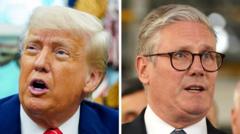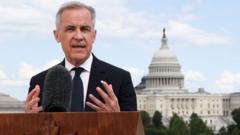In a surprising turn, President Trump paused his recently imposed tariffs, leading to a significant market rebound and raising questions about U.S. trade policy direction.
Trump Pauses Tariffs, Market Reacts with Surge

Trump Pauses Tariffs, Market Reacts with Surge
President reverses steep tariffs after market turmoil, indicating potential for exemptions
Markets experienced a notable surge following President Trump’s abrupt decision to halt new tariffs initially imposed on various trading partners. Shortly after announcing the steep levies, Trump revealed that most tariffs would be on hold for 90 days—potentially allowing certain U.S. companies to receive exemptions. While many nations now face a standard 10 percent tariff, China’s retaliatory tariffs climbed to a staggering 125 percent.
The reaction from Wall Street was immediate and positive, with the S&P 500 records its largest daily gain since 2008, increasing by 9.5 percent. This surge came in the wake of growing concerns among economists regarding the risk of recession following Trump's tariff hike to unprecedented levels.
White House officials claimed that the tariff suspension was part of a bigger strategic plan to ensure favorable trade deals. However, Trump himself admitted that the pause was primarily a response to turmoil in the bond market and declining investor confidence. Market analysts suggest that Trump's fixation on tariffs may reflect broader intentions to reshape the global trading landscape.
The ramifications of these tariffs extend beyond American borders; Canada's planned use of retaliatory tariffs to support local businesses underscores the global impact of U.S. trade policy. Even in the Philippines, businesses are viewing the growing trade conflict as an opportunity.
As discussions surrounding Trump’s tariffs continue, observers note the rising tension not only in the U.S. but also in Europe, where luxury goods manufacturers are increasingly worried about the potential market fallout. Censorship in China regarding tariff-related discussions suggests the sensitive nature of the issue, as businesses on both sides navigate this changing trade environment.





















